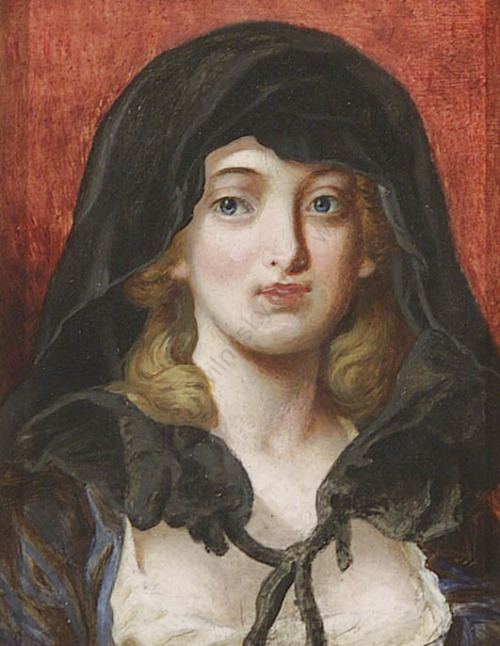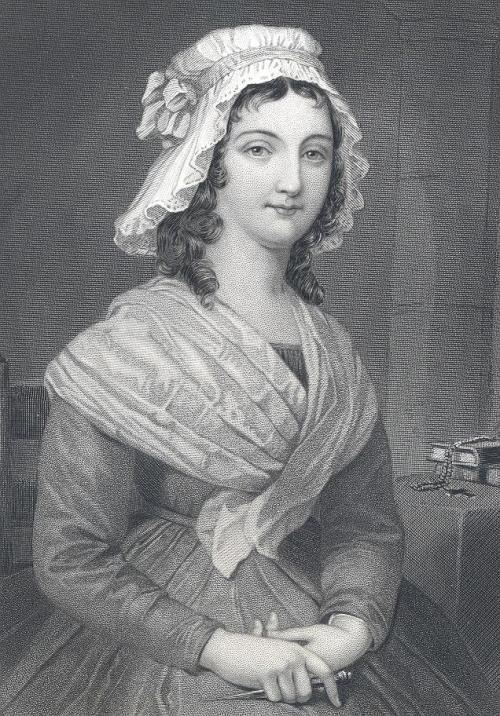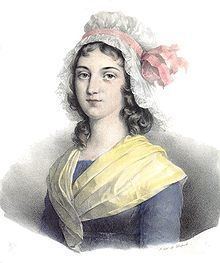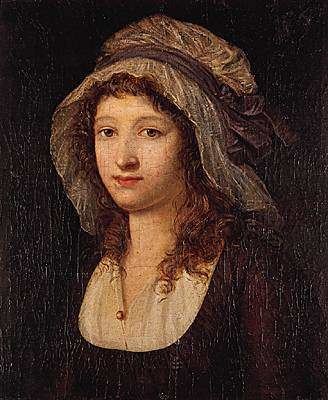Religion Roman Catholic Name Charlotte Corday | Role Journalist | |
 | ||
Full Name Marie-Anne Charlotte de Corday d'Armont Parent(s) Jacques Francois de Corday, seigneur d'ArmontCharlotte Marie Jacqueline Gaultier de Mesnival Similar People Jean‑Paul Marat, Jacques‑Louis David, Georges Danton, Maximilien Robespierre, Olympe de Gouges | ||
Charlotte corday partie 2
Marie-Anne Charlotte de Corday d'Armont (27 July 1768 – 17 July 1793), known as Charlotte Corday ([kɔʁdɛ]), was a figure of the French Revolution. In 1793, she was executed by guillotine for the assassination of Jacobin leader Jean-Paul Marat, who was in part responsible for the more radical course the Revolution had taken through his role as a politician and journalist. Marat had played a substantial role in the political purge of the Girondins, with whom Corday sympathized. His murder was memorialized in the painting The Death of Marat by Jacques-Louis David, which shows Marat's dead body after Corday stabbed him in his medicinal bath. In 1847, writer Alphonse de Lamartine gave Corday the posthumous nickname l'ange de l'assassinat (the Angel of Assassination).
Contents
- Charlotte corday partie 2
- Al Stewart Charlotte Corday from Famous Last Words 1993
- Biography
- Political influence
- Marats assassination
- Trial and execution
- Aftermath
- The Revolution and Women
- References

Al Stewart - Charlotte Corday (from "Famous Last Words" - 1993)
Biography

Born in Saint-Saturnin-des-Ligneries, a hamlet in the commune of Écorches (Orne), in Normandy, Charlotte Corday was a member of a minor aristocratic family. She was a fifth-generation matrilineal descendant of the dramatist Pierre Corneille. Her parents were cousins.

While Corday was a young girl, her older sister and their mother, Charlotte Marie Jacqueline Gaultier de Mesnival, died. Her father, Jacques François de Corday, Seigneur d'Armont (1737–1798), unable to cope with his grief over their death, sent Corday and her younger sister to the Abbaye aux Dames convent in Caen, where she had access to the abbey's library and first encountered the writings of Plutarch, Rousseau and Voltaire. After 1791, she lived in Caen with her cousin, Madame Le Coustellier de Bretteville-Gouville. The two developed a close relationship, and Corday was the sole heir to her cousin's estate.

Corday's physical appearance is described on her passport as "five feet and one inch... hair and eyebrows auburn,eyes gray, forehead high, mouth medium size, chin dimpled, and an oval face."
Political influence
After the revolution radicalized further and headed towards terror, Charlotte Corday began to sympathize with the Girondins. She admired their speeches and grew fond of many of the Girondist groups whom she met while living in Caen. She respected the political principles of the Girondins and came to align herself with their thinking. She regarded them as a movement that would ultimately save France. The Gironde represented a more moderate approach to the revolution and they, like Corday, were skeptical about the direction the revolution was taking. They opposed the Montagnards, who advocated a more radical approach to the revolution, which included the extreme idea that the only way the revolution would survive invasion and civil war was through terrorizing and executing those opposed to it. The opposition to this radical thinking, coupled with the influence of the Gironde, ultimately led Corday to carry out her plan to murder the most radical of them all, Jean-Paul Marat.
Corday's action aided in restructuring the private versus public role of the woman in society at the time. The idea of women as worthless beings was challenged, and Corday was considered a hero to those who were against the teachings of Marat. There have been suggestions that her act incited the banning of women's political clubs, and the executions of female activists such as the Girondist Madame Roland.
The influence of Girondin ideas on Corday is evident in her words at her trial: "I knew that he Marat was perverting France. I have killed one man to save a hundred thousand." As the revolution progressed, the Girondins had become progressively more opposed to the radical, violent propositions of the Montagnards such as Marat and Robespierre. Corday's notion that she was saving a hundred thousand lives echoes this Girondin sentiment as they attempted to slow the revolution and reverse the violence that had escalated since the September Massacres of 1792.
Marat's assassination
Jean-Paul Marat was a member of the radical Jacobin faction which had a leading role during the Reign of Terror. As a journalist, he exerted power and influence through his newspaper, L'Ami du peuple ("The Friend of the People").
Corday's decision to kill Marat was stimulated not only by her revulsion at the September Massacres, for which she held Marat responsible, but by her fear of an all-out civil war. She believed that Marat was threatening the Republic, and that his death would end violence throughout the nation. She also believed that King Louis XVI should not have been executed. Corday believed in a structure like that of Ancient Greece or Rome, a structure the realization of which was made unlikely by the efforts of Marat.
On 9 July 1793, Corday left her cousin, carrying a copy of Plutarch's Parallel Lives, and went to Paris, where she took a room at the Hôtel de Providence. She bought a kitchen knife with a six-inch blade. She then wrote her Addresse aux Français amis des lois et de la paix ("Address to the French people, friends of Law and Peace") to explain her motives for assassinating Marat.
Initially, she planned to assassinate Marat in front of the entire National Convention, intending to make an example out of him, but upon arriving in Paris she discovered that Marat no longer attended meetings because his health was deteriorating due to a skin disorder (perhaps dermatitis herpetiformis). She was then forced to change her plan. She went to Marat's home before noon on 13 July, claiming to have knowledge of a planned Girondist uprising in Caen; she was turned away by Catherine Evrard, the sister of his fiancee Simonne. On her return that evening, Marat admitted her. At the time, he conducted most of his affairs from a bathtub because of his skin condition. Marat wrote down the names of the Girondists that she gave to him, and she then pulled out the knife and plunged it into his chest. He called out, Aidez-moi, ma chère amie! ("Help me, my dear friend!") and died.
This is the moment memorialized by Jacques-Louis David's painting (illustration, right). The iconic pose of Marat dead in his bath has been reviewed from a different angle in Baudry's posthumous painting of 1860, both literally and interpretatively: Corday, rather than Marat, has been made the hero of the action.
In response to Marat's dying shout Simonne Evrard rushed into the room. She was joined by a distributor of his newspaper, who seized Corday. Two neighbors, a military surgeon and a dentist, attempted to revive Marat. Republican officials arrived to interrogate Corday and to calm a hysterical crowd who appeared ready to lynch her.
Trial and execution
Corday underwent three separate cross-examinations by senior revolutionary judicial officials, including the President of the Revolutionary Tribunal and the chief prosecutor. She stressed that she was a republican and had been so even before the Revolution, citing the values of ancient Rome as an ideal model.
The focus of the questioning was to establish whether she had been part of a wider Girondist conspiracy. Corday remained constant in insisting that "I alone conceived the plan and executed it." She referred to Marat as a "hoarder" and a "monster" who was respected only in Paris. She credited her fatal knifing of Marat with one blow not to practicing in advance but to luck.
On 17 July 1793, four days after Marat was killed, Corday was executed by the guillotine, wearing the red overblouse denoting a condemned traitor who had assassinated a representative of the people. Standing alone in the tumbril amid a large and curious crowd she remained calm, although drenched by a sudden summer rainfall. Her corpse was disposed of in the Madeleine Cemetery.
Following her sentencing Corday asked the court if her portrait could be painted, purportedly to record her true self. She made her request pleading, "Since I still have a few moments to live, might I hope, citizens, that you will allow me to have myself painted." Given permission, she selected as the artist a National Guard officer, Jean-Jacques Hauer, who had already begun sketching her from the gallery of the courtroom. Hauer's likeness (see above) was completed shortly before Corday was summoned to the tumbril, after she had viewed it and suggested a few changes.
Aftermath
After Corday's decapitation, a man named Legros lifted her head from the basket and slapped it on the cheek. Charles-Henri Sanson, the executioner, indignantly rejected published reports that Legros was one of his assistants. Sanson stated in his diary that Legros was in fact a carpenter who had been hired to make repairs to the guillotine. Witnesses report an expression of "unequivocal indignation" on her face when her cheek was slapped. The oft-repeated anecdote has served to suggest that victims of the guillotine may in fact retain consciousness for a short while, including by Albert Camus in his Reflections on the Guillotine. ("Charlotte Corday's severed head blushed, it is said, under the executioner's slap.").
This offense against a woman executed moments before was considered unacceptable and Legros was imprisoned for three months because of his outburst.
Jacobin leaders had her body autopsied immediately after her death to see if she was a virgin. They believed there was a man sharing her bed and the assassination plans. To their dismay, she was found to be virgo intacta (a virgin).
The assassination did not stop the Jacobins or the Terror: Marat became a martyr, a bust of him replaced a religious statue on the rue aux Ours and a number of place-names were changed to incorporate his.
Corday's act transformed the idea of what a woman was capable of, and to those who did not shun her for her act, she was a heroine. André Chénier, for example, wrote a piece in honor of Corday. This highlighted the "masculinity" possessed by Corday during the revolution.
La vertu seule est libre. Honneur de notre histoire, -Virtue alone is free. Honor of our history,
Notre immortel opprobre y vit avec ta gloire, -Our immortal opprobrium lives there with your glory,
Seule tu fus un homme, et vengeas les humains. -Only you were a man, and avenged the humans.
Et nous, eunuques vils, troupeau lâche sans âme, -And we, vile eunuchs, a cowardly herd without a soul,
Nous savons répéter quelques plaintes de femme, -We know how to repeat a few complaints from a woman,
Mais le fer pèserait a nos dèbiles mains. -But the iron would weigh our dear hands.
The Revolution and Women
Corday's act served as a turning point of views held of women during the revolutionary period. During the revolution women were given a new-found power resulting from the necessity of their being increasingly involved in the revolution. It is said that Corday's act served as a "Consolidation of a new system of gender relations during the revolution," because by entering into a new "public sphere," she challenged gender norms of this time period.
It is suggested that this newfound power resulting from women's taking revolutionary action, led to the death of some powerful women of this era, including Marie Antoinette, Olympe de Gouges, and Madame Roland. Corday's killing of such an influential leader during the revolution angered many people. Her actions were described by many as disquieting as well as transgressive. This behavior left a lasting impression on male revolutionaries because even though women were not at the forefront, they nonetheless had a place in the revolution, but not a prominent enough one to counteract a woman committing such an act.
Her killing of Marat was considered vile, an "arch-typically masculine statement," which reaction showed that whether or not one approved of what she did, it is clear that the murder of Marat changed the political role and position of women during the French Revolution. Corday was surprised by the reaction of revolutionary women stating, "As I was truly calm I suffered from the shouts of a few women. But to save your country means not noticing what it costs."
After Corday murdered Marat, the majority of women distanced themselves from her because they believed that what she had done would spark a reaction against the now developing feminist movement, which was already facing criticism. Also, many of these women were attached to Marat in that they were supporters of his revolutionary efforts and sympathized with him as citizens of France.
